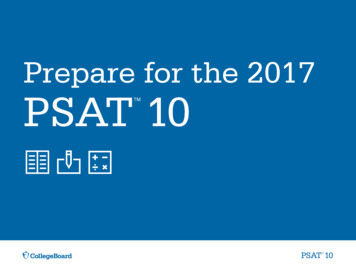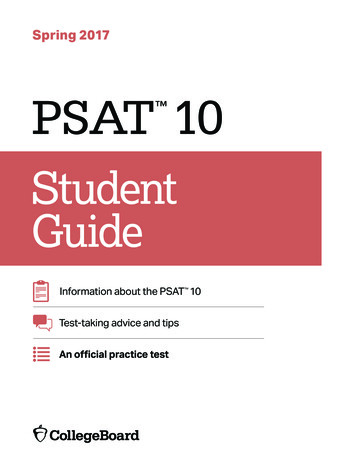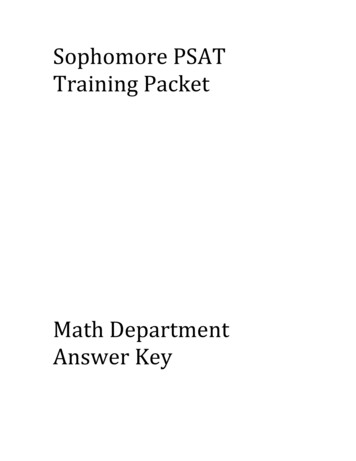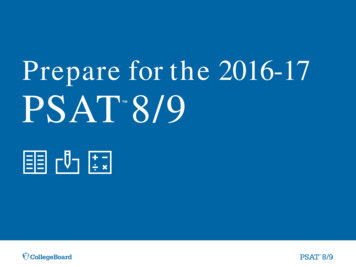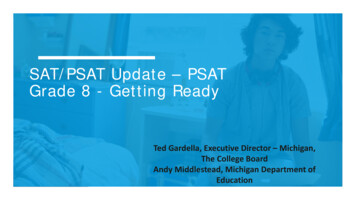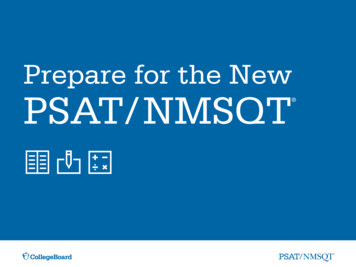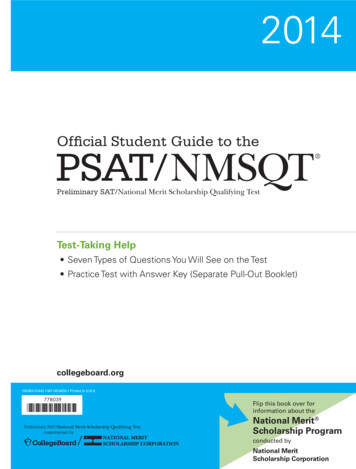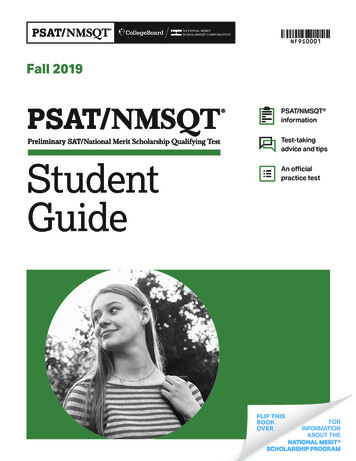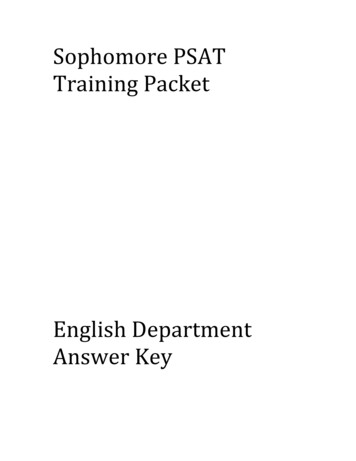
Transcription
Sophomore PSATTraining Packet2016-17English DepartmentAnswer Key
PSAT/NMSQT Practice Test #1AnswerExplanations
PSAT/NMSQT Practice Test #1L1Reading Test Answer ExplanationsReading Test Answer ExplanationsQuestion 1The main purpose of the passage is to(A)describe a main character and a significant change in her life.(B)provide an overview of a family and a nearby neighbor.(C)discuss some regrettable personality flaws in a main character.(D) explain the relationship between a main character and her father.Item Difficulty: EasyContent: Rhetoric / Analyzing purposeBest Answer: AChoice A is the best answer. Emma Woodhouse’s life and family are discussed,including the marriage of her governess Miss Taylor who then moves out ofEmma’s home. In line 74, Emma wonders how she is to “bear the change” of MissTaylor’s departure, which indicates its significance.Choices B and D are incorrect because the passage focuses more on Emma thanon her family and neighbors, and Emma’s relationship with her father is arelatively minor consideration. Choice C is also incorrect because Emma ischaracterized as handsome and clever with a happy disposition, and her arroganceis only briefly mentioned.Question 2Which choice best summarizes the first two paragraphs of the passage(lines 1-14)?(A)Even though a character loses a parent at an early age, she ishappily raised in a loving home.(B)An affectionate governess helps a character to overcome the loss ofher mother, despite the indifference of her father.(C)Largely as a result of her father’s wealth and affection, a characterleads a contented life.(D) A character has a generally comfortable and fulfilling life, but thenshe must recover from losing her mother.Item Difficulty: HardContent: Information and Ideas / SummarizingBest Answer: APage 1
PSAT/NMSQT Practice Test #1L1Reading Test Answer ExplanationsChoice A is the best answer. The passage indicates that Emma’s mother died longago and that Emma barely remembers her. Emma is raised by an affectionatefather and governess and is described as a person with a happy disposition.Choices B, C, and D are incorrect: Emma's father is not described as indifferent,Emma is not described as contented because of her father’s wealth, and Emmadoes not appear to suffer from the loss of her mother.Question 3The narrator indicates that the particular nature of Emma’s upbringingresulted in her .(D) inconsiderate.Item Difficulty: MediumContent: Information and Ideas / Reading closelyBest Answer: BChoice B is the best answer. According to the passage, Emma had “a dispositionto think a little too well of herself” (line 30). Thinking a “little too well of herself”means that Emma had an elevated opinion of herself, or that she was selfsatisfied.Choices A, C, and D are incorrect because Emma’s relationship with her father andMiss Taylor, the two characters who raised her, did not result in her beingdespondent, friendless, or inconsiderate.Question 4Which choice provides the best evidence for the answer to the previousquestion?(A) Lines 1-5 (“Emma . . . her”)(B) Lines 9-14 (“Her . . . affection”)(C) Lines 28-32 (“The real . . . enjoyments”)(D) Lines 32-34 (“The danger . . . her”)Item Difficulty: MediumContent: Information and Ideas / Citing textual evidenceBest Answer: CChoice C is the best answer. Lines 28-32 state that “The real evils indeed ofEmma’s situation were the power of having rather too much her own way, and aPage 2
PSAT/NMSQT Practice Test #1L1Reading Test Answer Explanationsdisposition to think a little too well of herself; these were the disadvantages whichthreatened alloy to her many enjoyments.” Thinking a “little too well of herself”means that Emma had an elevated opinion of herself, or that she was selfsatisfied.Choices A, B, and D are incorrect because they do not provide the best evidencefor Emma being self-satisfied. Choice A describes Emma’s positive traits, choice Bdescribes Emma’s affectionate relationship with Miss Taylor, and choice Ddiscusses only that Emma’s problems were negligible.Question 5As used in line 26, “directed” most nearly means(A)trained.(B)aimed.(C)guided.(D) addressed.Item Difficulty: MediumContent: Information and Ideas / Interpreting words and phrases in contextBest Answer: CChoice C is the best answer. In lines 25-27, Emma’s situation is described as“doing just what she liked; highly esteeming Miss Taylor’s judgment, but directedchiefly by her own.” In other words, Emma respects Miss Taylor’s opinion butmakes decisions directed, or guided, primarily by her own opinion.Choices A, B, and D are incorrect because lines 25-27 emphasize that in “doingwhat she liked” Emma was directed, or guided, by her own opinion. Emma’sopinion is not trained by, aimed at, or addressed by anyone else.Question 6As used in line 54, “want” most nearly means(A)desire.(B)lack.(C)requirement.(D) request.Item Difficulty: HardContent: Information and Ideas / Interpreting words and phrases in contextBest Answer: BPage 3
PSAT/NMSQT Practice Test #1L1Reading Test Answer ExplanationsChoice B is the best answer. Lines 53-55 describe how Emma felt a loss after MissTaylor married and moved out of Emma’s home: “but it was a black morning’swork for her. The want of Miss Taylor would be felt every hour of every day.” Inthis context, “want” means “lack.”Choices A, C, and D are incorrect because in this context “want” does not meandesire, requirement, or request.Question 7It can most reasonably be inferred that after Miss Taylor married, she had(A)less patience with Mr. Woodhouse.(B)fewer interactions with Emma.(C)more close friends than Emma.(D) an increased appreciation for Emma.Item Difficulty: EasyContent: Information and Ideas / Reading closelyBest Answer: BChoice B is the best answer. According to lines 76-81, following Miss Taylor’smarriage, “Emma was aware that great must be the difference between a Mrs.Weston only half a mile from them, and a Miss Taylor in the house; and with allher advantages, natural and domestic, she was now in great danger of sufferingfrom intellectual solitude.” This implies that since Miss Taylor’s marriage, the twocharacters see each other less often.Choice A is incorrect because the passage does not mention Miss Taylor’srelationship with Mr. Woodhouse. Choices C and D are incorrect because thepassage describes how Miss Taylor’s marriage might affect Emma but not how themarriage might affect Miss Taylor.Question 8Which choice provides the best evidence for the answer to the previousquestion?(A)Line 37 (“Miss . . . married”)(B)Lines 47-48 (“The event . . . friend”)(C)Lines 61-66 (“A large . . . recollection”)(D) Lines 74-81 (“How . . . solitude”)Item Difficulty: MediumContent: Information and Ideas / Citing textual evidenceBest Answer: DPage 4
PSAT/NMSQT Practice Test #1L1Reading Test Answer ExplanationsChoice D is the best answer because lines 74-81 refer to Emma’s new reality of“intellectual solitude” after Miss Taylor moved out of the house.Choices A, B, and C are incorrect because none of these choices support the ideathat Miss Taylor and Emma had fewer interactions following Miss Taylor’smarriage. Choice A mentions Emma’s “sorrow” towards losing Miss Taylor,choice B introduces how Miss Taylor may benefit from the marriage, and choice Cdescribes Emma’s and Miss Taylor’s close friendship.Question 9Which situation is most similar to the one described in lines 84-92 (“Theevil . . . time”)?(A)A mother and her adult son have distinct tastes in art and musicthat result in repeated family arguments.(B)The differences between an older and a younger friend aremagnified because the younger one is more active and athletic.(C)An older and a younger scientist remain close friends despite thefact that the older one’s work is published more frequently.(D) The age difference between a high school student and a collegestudent becomes a problem even though they enjoy the same diversions.Item Difficulty: MediumContent: Information and Ideas / Reading closelyBest Answer: BChoice B is the best answer. Lines 84-92 describe the fact that though Emma andher father have a loving relationship, Mr. Woodhouse is much older than Emmaand in poor health. For these reasons, he did not make a good companion for thespirited, young Emma. Their relationship is most similar to a friendship betweenan older and younger person that is negatively affected by the fact one is morelively and active than the other.Choice A is incorrect because Emma and her father did not have regulararguments. Choice C is incorrect because the relationship between Emma and Mr.Woodhouse was affected by the difference in their age and activity, not anyrelative successes one or the other might have had. Choice D is incorrect becausethere is no indication that Emma and her father enjoyed the same activities.Page 5
PSAT/NMSQT Practice Test #1L1/H1Reading Test Answer ExplanationsQuestion 10As used in line 10, “plot” most nearly means(A)mark.(B)form.(C)plan.(D) claim.Item Difficulty: EasyContent: Information and Ideas / Interpreting words and phrases in contextBest Answer: CChoice C is the best answer. The first paragraph discusses the “vast informaleconomy driven by human relationships” (lines 6-7) that existed in the SovietUnion as a result of the gaps in the official economy. Lines 9-10 state that “TheSoviet people didn’t plot how they would build these [social] networks.” In thiscontext, the word “plot” means “plan”; the paragraph is implying that theinformal economy grew up spontaneously, without premeditation or planning.Choices A, B, and D are incorrect because in this context “plot” does not meanmark, form, or claim.Question 11The references to the shoemaker, the programmer, and the apple farmerin lines 37-40 (“We can easily . . . community”) primarily serve to(A)illustrate the quality of products and services in countries aroundthe world.(B)emphasize the broad reach of technologies used to connect people.(C)demonstrate that recommendations made online are trustworthy.(D) call attention to the limits of the expansion of the global economy.Item Difficulty: EasyContent: Rhetoric / Analyzing text structureBest Answer: BChoice B is the best answer. The third paragraph of the passage (lines 27-46)describes how new technologies are affecting new economies, as people are usingsocial media to vet people and businesses through eBay, Twitter, Facebook, andYouTube. The author uses broad examples (a business in South America, a personin Asia, and a farmer in the reader’s local community) to imply that thesetechnologies have a global reach.Choice A is incorrect because the passage provides no comment about the qualityof products or services. Choice C is incorrect because the passage never alludes toPage 6H1
PSAT/NMSQT Practice Test #1W1Writing and Language Test Answer ExplanationsWriting and Language Test AnswerExplanationsQuestion 1(A) NO CHANGE(B) see an annual loss of 63.2 billion each year(C) lose 63.2 billion annually(D) have a yearly loss of 63.2 billion annuallyItem Difficulty: MediumContent: Effective Language Use / ConcisionBest Answer: CChoice C is the best answer because it states the situation succinctly and is free ofredundancies.Choices A, B, and D are incorrect because all three contain a redundancy in whicha reference to the annual nature of the loss is stated twice; for example, Choice Astates “yearly” and “annually.”Question 2(A) NO CHANGE(B) main things leading up to(C) huge things about(D) primary causes ofItem Difficulty: MediumContent: Effective Language Use / Style and toneBest Answer: DChoice D is the best answer because the use of language is correct for standardwritten English and matches the formal tone of the passage.Choices A and C are incorrect because both rely on colloquial language,specifically “big” and “huge,” which strays from the formal tone of the article.Additionally, “things” in Choice C is vague and informal. Choice B is incorrect forthe same reason.Page 29
PSAT/NMSQT Practice Test #1W1Writing and Language Test Answer ExplanationsQuestion 3(A) NO CHANGE(B) have spent(C) spends(D) are spentItem Difficulty: MediumContent: Conventions of Usage / Agreement / Subject-verb agreementBest Answer: CChoice C is the best answer because the verb “spends” grammaticallycorresponds with the singular noun “American.”Choices A, B, and D are incorrect because, in each instance, the noun and verb donot grammatically correspond. The verbs “spend,” “have spent” and “are spent”would correspond with a plural noun, but not with the singular noun “American.”Question 4(A) NO CHANGE(B) workers; managers(C) workers, managers,(D) workers, managersItem Difficulty: MediumContent: Conventions of Punctuation / Within-sentence punctuationBest Answer: DChoice D is the best answer because it provides punctuation that creates acomplete sentence with clauses whose relationship to one another is clear.Choice A is incorrect because it results in a sentence fragment. Choice B isincorrect because the first clause is dependent, signaled by the conditional phrase“As long as,” so a semicolon cannot be used. Choice C is incorrect because thecomma following “managers” inappropriately separates the noun from the verb“should champion.”Page 30
PSAT/NMSQT Practice Test #1W1Writing and Language Test Answer ExplanationsQuestion 5To make this paragraph most logical, sentence 3 should be placed(A) where it is now.(B) before sentence 1.(C) after sentence 1.(D) after sentence 4.Item Difficulty: HardContent: Organization / Logical sequenceBest Answer: CChoice C is the best answer. Sentence 3 logically follows the statement in sentence1 where readers learn that part of the problem is the work itself. Sentence 3 thentells readers what about the work has caused the decrease in sleep: “The hours theaverage American spend[s] working have increased dramatically .”Choices A, B, and D are incorrect because they do not order the information in theparagraph logically.Question 6At this point, the writer is considering adding the following sentence.“Even fifteen-minute power naps improve alertness, creativity, andconcentration.”Should the writer make this addition here?(A) Yes, because it demonstrates that the benefits of napping can begained without sacrificing large amounts of work time.(B) Yes, because it explains the methodology of the studies mentioned inthe previous sentence.(C) No, because a discussion of the type of nap workers take is notimportant to the writer’s main point in the paragraph.(D) No, because it contradicts the writer’s discussion of napping in theprevious sentences.Item Difficulty: MediumContent: Development / FocusBest Answer: APage 31
PSAT/NMSQT Practice Test #1W1Writing and Language Test Answer ExplanationsChoice A is the best answer because it adds relevant information in support of theclaim that companies should allow their employees to take naps.Choice B is incorrect because the prospective sentence does not explainmethodology. Choice C is incorrect because the example in the sentence providesadditional information in support of napping. Choice D is incorrect because thereis no contradiction.Question 7Which choice provides a supporting example that reinforces the mainpoint of the sentence?(A) NO CHANGE(B) including a lower risk of cardiovascular problems such as heart attackand stroke.(C) which are essential in an era of rising health care costs.(D) in addition to making employees more efficient.Item Difficulty: HardContent: Development / SupportBest answer: BChoice B is the best answer because it offers a specific example of a long-termhealth benefit that could lead to “reduced health care costs.”Choices A, C, and D are incorrect because they offer no supporting examples oflong-term health benefits that could reduce health care costs.Question 8(A) NO CHANGE(B) gently wake(C) gently to wake(D) gentle waking ofItem Difficulty: MediumContent: Sentence Structure / Sentence formation / Parallel structureBest Answer: BChoice B is the best answer because the verb “wake” is consistent with thepreceding verbs in the series, “block” and “play.” Furthermore, choice B providesa verb that creates a grammatically complete and standard sentence.Page 32
PSAT/NMSQT Practice Test #1W1Writing and Language Test Answer ExplanationsChoices A, C, and D are incorrect because, in each instance, the verb is notconsistent with the preceding verbs in the series, “block” and “play.”Question 9(A) NO CHANGE(B) among(C) between(D) intoItem Difficulty: EasyContent: Conventions of Usage / Conventional expressionBest Answer: BChoice B is the best answer because, in this context, the preposition “among” isthe only idiomatic choice: napping can be promoted “among” people but not“throughout,” “between,” or “into” them.Choices A, C, and D are incorrect because the prepositions “throughout,”“between,” and “into” are unidiomatic in this context.Question 10(A) NO CHANGE(B) but it benefits(C) as also to(D) but also toItem Difficulty: MediumContent: Sentence Structure / Sentence formation / Subordination andcoordinationBest Answer: DChoice D is the best answer because it completes a parallel construction in whichtwo elements are compared. In this construction “but also to” is parallel to “notonly to” and thus is the only choice that creates a grammatically complete andstandard sentence. The “not only but also” construction is also known as acorrelative conjunction, meaning that these two phrases should always travel inpairs.Choices A and C are incorrect because they fail to complete the comparison thatthe preposition “not only to” signals. Choice B is incorrect because it results in arun-on and incomplete sentence.Page 33
PSAT/NMSQT Practice Test #1W1Writing and Language Test Answer ExplanationsQuestion 11The writer wants a concluding sentence that restates the main argument ofthe passage. Which choice best accomplishes this goal?(A) NO CHANGE(B) Clearly, employers should consider reducing employees’ hours whenthey are overworked.(C) Companies should consider employee schedules carefully whenimplementing a napping policy.(D) More businesses should follow their lead and embrace napping on thejob.Item Difficulty: MediumContent: Organization / Introductions, conclusions, and transitionsBest Answer: DChoice D is the best answer because it logically concludes the essay, the mainargument of which is that napping during the workday boosts employeeproductivity and morale and reduces costs associated with poor health andabsences.Choices A, B, and C are incorrect because none of these choices restates the mainargument of the passage.Question 12(A) NO CHANGE(B) pollination: this is(C) pollination,(D) pollination;Item Difficulty: MediumContent: Conventions of Punctuation / Nonrestrictive and parenthetical elementsBest Answer: CChoice C is the best answer because it provides the appropriate punctuation forthe nonrestrictive modifying clause “including honeybee pollination.” Because theclause is not essential to the sentence, it should be offset with commas (or othermatching punctuation). Since a comma is used before the clause, a comma mustbe used after it as well.Choices A and D are incorrect because the punctuation does not match the commathat sets off the nonrestrictive modifying clause “including honeybee pollination.”Page 34
PSAT/NMSQT Practice Test #1W1Writing and Language Test Answer ExplanationsChoice B is incorrect because “this is” is unnecessarily wordy.Question 13(A) NO CHANGE(B) highlights the potentially disastrous effects(C) highlight the potentially disastrous effects(D) highlight the potentially disastrous affectsItem Difficulty: MediumContent: Conventions of Usage / Frequently confused wordsBest Answer: BChoice B is the best answer because the verb “highlights” grammaticallycorresponds with the singular noun “the importance of bees.” Additionally,“effects” is the correct noun to describe outcomes.Choices A and D are incorrect because “affects” is the incorrect word in thiscontext. Choice C is incorrect because there is no subject-verb agreement betweenthe singular noun “the importance of bees” and the verb “highlight.”Question 14(A) NO CHANGE(B) Known as colony(C) It is known as colony(D) ColonyItem Difficulty: MediumContent: Sentence Structure / Sentence formation / Modifier placementBest Answer: BChoice B is the best answer because it provides a dependent clause thatadequately introduces the main subject, colony collapse disorder, whichcorresponds directly to the subject in the second clause: “this phenomenon.”Choice A is incorrect because “They” has no clear antecedent and creates acomma splice. Choice C is incorrect because it also results in a comma splice.Choice D is incorrect because it creates redundancy with the following nounphrase “this phenomenon.”Page 35
PSAT/NMSQT Practice Test #1W1Writing and Language Test Answer ExplanationsQuestion 15Which choice offers the most accurate interpretation of the data in thechart?(A)(B)(C)(D)NO CHANGEbeen above the acceptable range.not changed noticeably from year to year.greatly increased every year.Item Difficulty: MediumContent: Development / Quantitative informationBest Answer: BChoice B is the best answer because it accurately represents the information in thechart.Choice A is incorrect because in the 2011-2012 winter season, bee mortality ratesfell below 25% of the bee colony. Choice C is incorrect because, according to thechart, bee mortality rates have varied noticeably year to year. Choice D is incorrectfor a similar reason. The chart shows that, year to year, bee mortality rates haveboth increased and decreased.Question 16Which choice offers an accurate interpretation of the data in the chart?(A) NO CHANGE(B) portion of bees lost was double what it had been the previous year,rising to(C) number of losses, which had fallen within the acceptable range theprevious year, rose to(D) portion of total colonies lost rose almost 10 percentage points, with aloss ofItem Difficulty: MediumContent: Development / Quantitative informationBest Answer: DChoice D is the best answer because it accurately represents the comparison inbee population loss between the 2010 2012 and 2012 2013 periods. Compared tothe 2011 2012 winter season, bee loss was almost 10 percentage points higher thefollowing year.Page 36
PSAT/NMSQT Practice Test #1W1Writing and Language Test Answer ExplanationsChoice A is incorrect because it states that compared to the preceding years, beelosses fell in 2012 2013 when, according to the data, the opposite was true. ChoiceB is incorrect because the bee loss in 2012 2013 did not double from 2011 2012.Given that bee loss in 2011 2012 hovered around 22%, double would be around44%, while the chart says bee loss in 2012 2013 was just over 30%. Choice C isincorrect because it makes a false statement: the number of losses had not “fallenwithin the acceptable range the previous year.”Question 17Which choice most smoothly and effectively introduces the writer’sdiscussion of studies of CCD in this paragraph?(A) NO CHANGE(B) Bees are vanishing, and according to studies there are severalpossible reasons for this trend.(C) Several possible reasons, offered by studies, may explain why beesare vanishing.(D) DELETE the underlined sentence.Item Difficulty: MediumContent: Effective Language Use / SyntaxBest Answer: AChoice A is the best answer. It adequately introduces the paragraph’s main topic ina grammatically complete and standard manner. In addition, its use of the passivevoice (“Studies have offered”) establishes a pattern that the next sentencemaintains (“One reason that is often cited”).Choices B and C are incorrect because each is redundant. In B, there is no need torefer to bees vanishing and “this trend” in the same sentence. In C, there is noneed to specify that “reasons . . . may explain.” Choice D is incorrect because if theparagraph were to begin with the sentence “One reason that is often cited ,” thewriter’s discussion of studies of CCD would not be introduced smoothly andeffectively.Page 37
PSAT/NMSQT Practice Test #1W1Writing and Language Test Answer ExplanationsQuestion 18At this point, the writer is considering adding the following sentence.“Prolonged exposure to neonicotinoids has been shown to increase bees’vulnerability to disease and parasitic mites.”Should the writer make this addition here?(A) Yes, because it provides support for the claim made in the previoussentence.(B) Yes, because it introduces a new idea that will become important laterin the passage.(C) No, because it would be better placed elsewhere in the passage.(D) No, because it contradicts the main idea of the passage.Item Difficulty: MediumContent: Development / FocusBest Answer: AChoice A is the best answer because the information supports the preceding claimby showing how lingering neonicotinoids impact bees in particular. The previoussentence notes “one reason” why bees are vanishing (the use of neonicotinoids),and this proposed sentence usefully elaborates on how neonicotinoids harm bees.Choices B, C, and D are incorrect because the information doesn’t introduce a newidea that will become important later in the passage, belong elsewhere in thepassage, or contradict the main idea.Question 19(A) NO CHANGE(B) is a pretty big deal.(C) can’t be put on the back burner.(D) cannot be ignored.Item Difficulty: EasyContent: Effective Language Use / Style and toneBest Answer: DChoice D is the best answer because the diction is consistent with the article’s toneand style.Choices A, B, and C are incorrect because the casual tone and style of the phrases“is not to be scoffed at,” “is a pretty big deal,” and “can’t be put on the backburner” deviate from the more formal tone and style established in the rest of thearticle.Page 38
PSAT/NMSQT Practice Test #1W1Writing and Language Test Answer ExplanationsQuestion 20(A) NO CHANGE(B) crops, this is an expensive proposition when there is a shortage ofbees.(C) crops, an expensive proposition when there is a shortage of bees.(D) crops; an expensive proposition when there is a shortage of bees.Item Difficulty: HardContent: Sentence Structure / Sentence formation / Sentence boundariesBest Answer: CChoice C is the best answer because it creates a grammatically correct relationshipbetween an independent clause and a dependent one.Choices A and D are incorrect because a semicolon should link two independentclauses in order to be grammatically correct; in each instance the second clause isdependent. Choice B is incorrect because it creates a comma splice.Question 21(A) NO CHANGE(B) there(C) their(D) itsItem Difficulty: EasyContent: Conventions of Usage / Possessive determinersBest Answer: CChoice C is the best answer because it provides the correct possessive form of aplural noun, the farmers who are the main subject of the sentence.Choices A and B are incorrect because neither is the correct possessive form of“they.” Choice A is a contraction of the subject “they” and the verb “are,” whileChoice B is an adverb that refers to a place or a particular point in time. Choice D isincorrect because it is the possessive form of a singular, not a plural, noun.Page 39
PSAT/NMSQT Practice Test #1W1Writing and Language Test Answer ExplanationsQuestion 22The writer wants a conclusion that addresses the future of efforts tocombat CCD. Which choice results in the passage having the mostappropriate concluding sentence?(A) NO CHANGE(B) Still, bee colonies have experienced such devastating losses that theconsequences of the issue have been felt worldwide.(C) Although CCD is a relatively new phenomenon, scientists have beenstudying other aspects of honeybees for over a century.(D) Genetic variation in bee colonies generally improves bees’productivity, disease resistance, and ability to regulate body temperature.Item Difficulty: HardContent: Organization / Introductions, conclusions, and transitionsBest Answer: AChoice A is the best answer because the passage already has an appropriateconcluding sentence that addresses “the future of efforts to combat CCD.” Thissentence supports the last paragraph’s focus on “commonsense measures” byoutlining potential CCD-prevention efforts such as “[a] decrease in the use ofcertain pesticides, herbicides, and fungicides” and stating that these efforts “couldbegin a shift in a favorable direction.”Choices B, C, and D are incorrect because they don’t address “the future of effortsto combat CCD” that the question demands. Choice B describes the current impactof diminishing bee populations instead of discussing the future. Choice Cintroduces a new topic that departs from the paragraph’s main topic. Choice Dintroduces a related topic that needs further elaboration.Question 23(A) NO CHANGE(B) stood;(C) stood—(D) stoodItem Difficulty: EasyContent: Conventions of Punctuation / Unnecessary punctuationBest Answer: DChoice D is the best answer because it creates a grammatically complete andstandard sentence.Page 40
PSAT/NMSQT Practice Test #1W1Writing and Language Test Answer ExplanationsChoices A, B, and C are incorrect because each inserts unnecessary punctuationthat disrupts the meaning of the sentence, which is to state where Giuseppe Ferruastood.Question 24(A) NO CHANGE(B) inside(C) for(D) onItem Difficulty: EasyContent: Conventions of Usage / Conventional expressionBest Answer: AChoice A is the best answer because the preposition “with” correctly reflects therelationship between the subject, verb, and object: “landscape,” “dotted,” and“vineyards,” respectively.Choices B, C, and D are incorrect because each provides a preposition that doesnot appropriately represent the relationship between the subject, verb, and object.A landscape can be dotted “with” vineyards; it cannot be dotted “inside,” “for,” or“on” vineyards.Question 25(A) NO CHANGE(B) however,(C) by contrast,(D) thereafter,Item Difficulty: MediumContent: Organization / In
PSAT/NMSQT Practice Test #1 Reading Test Answer Explanations Choice A is the best answer. The passage indicates that Emma’s mother died long ago and that Emma barely remembers her. Emma is raised by an affectionate father and governe
